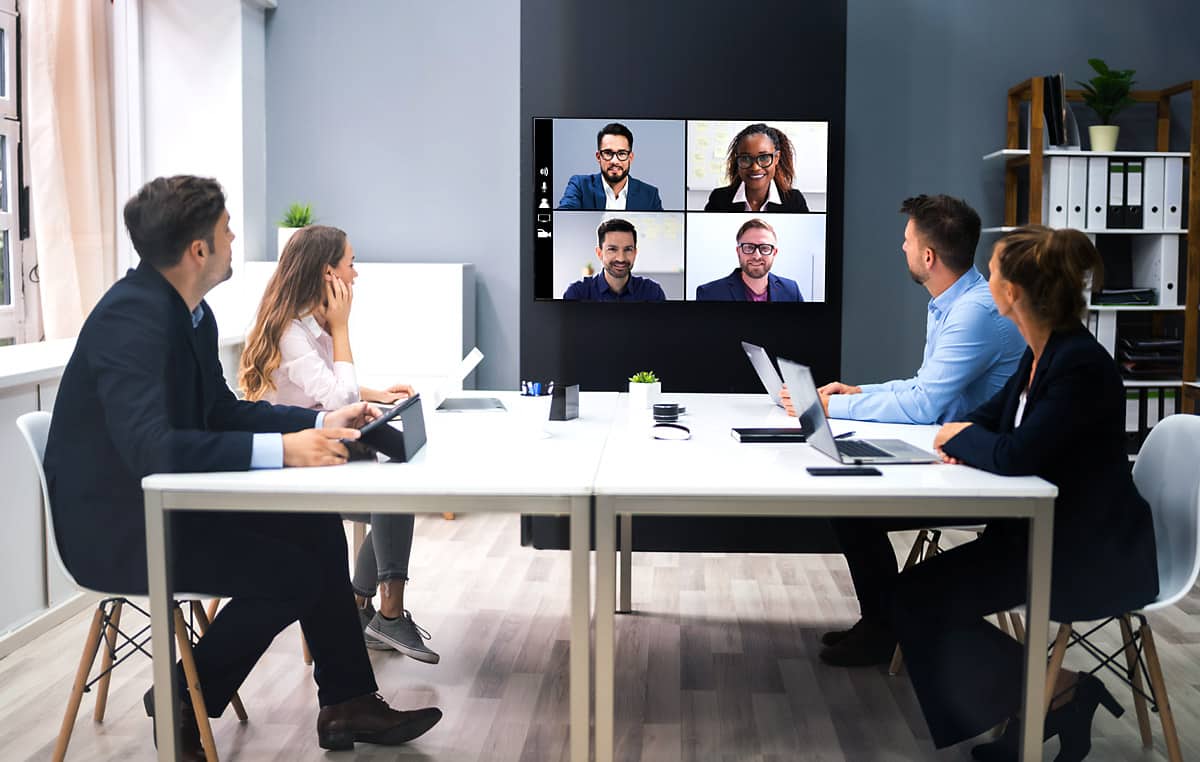
The Ultimate Guide to Your Conference Room Setup
Whether you’re implementing an agile working environment where employees are hot-desking or working from home – or if you simply have a large team of employees in different locations – video conferencing is now a key part of everyday working life. We simply cannot do without virtual collaboration tools as they’re such an important part of modern organizations.
No matter how user-friendly conference room equipment claims to be, it’s not always the case from an employee’s perspective. There are many variables that impact the functioning of your conference room and setting it up with the right equipment is going to make sure those unproductive meetings that could have been substituted by an email or a quick call, are a thing of the past.
To save yourself from those meeting room disasters, here is our ultimate guide for setting up your conference room.
The role of layout in conference room setups
Depending on the nature of your business, conference rooms typically cater for a variety of meeting types. The first step of our guide considers the layout of your meeting room and to help determine the best approach, you need to consider what type of meetings your conference room be used for.
During the pandemic, conference rooms can be repurposed to accommodate socially distanced workstations, or as ‘overspill’ areas that provide a safe place for people to eat their lunch when the cafeteria is full. Click here to find out more about automating a COVID-safe return to work or check out these free resources.
If the meetings are going to be purely informational, sharing facts and knowledge, the room needs to be suited to presentations and lectures. Or, if they’re going to be used regularly for product demos, you’ll want to have good quality equipment and, if necessary, space to showcase your products.
The most common types of layout used in conference room setups are:
- Traditional Conference Layout – This is the layout achieved by placing chairs around a conference table which is best for interactive meetings and discussions.
- U Shaped Layout – This shape is achieved by placing tables end to end to form a U shape and the chairs then placed around the outside of the tables. Most suitable for presentations or discussions.
Once the layout has been decided on, you then need to think of the following:
- Outlets – Are sufficient ports and outlets available to allow individuals to charge personal devices when required, such as laptops or tablets that may be used for note-taking purposes?
- Lighting – Is there sufficient lighting in the room to cater for video conferencing?
- Cameras, speakers, mics – Consider the placement of the camera, speakers and microphones. Ideally the camera should be placed above the video display. Larger conference rooms will require more microphones and speakers for attendees.
Choose the right video displays
Monitors can enhance the conferencing experience as they allow everyone to remain on the same page throughout the meeting. Choosing the right display is critical when you’re trying to share a screen or even when you’re on a video call with clients. Here are a few things to take into consideration:
- Display size – For small meeting and conference rooms, a display size of 60 inches works well and is cost-effective, which is why many organizations use 60” TVs. If you have a larger room, to save money it may be worth using a projector, as the display size can then be easily adjusted.
- Type of display – Some businesses may decide to use TVs, projectors, LCD or LED displays.
- Mounting height – This is actually more important than you might think, because when it’s done right, it can give that eye contact feel when you’re talking with clients or team members via video conferencing. Placing the camera in the correct spot is also important. It’s beneficial to place it on top, however if the display is relatively large, consider having one below the screen as well.
Choose the right conference room technologies
Collaboration technologies and virtual meeting solutions are now a necessity for many organizations, especially when they have teams working from home, and there’s a range of technology to choose from. Conference room solutions come with video, messaging, content sharing – everything you need for video conferencing with clients or other team members.
If you’re going to be using your conference room to regularly host webinars, you’ll need software that can facilitate large numbers of people joining; and that provides a good mobile experience. Zoom is currently the popular choice for this. If it’s just going to be for your team or new and current client meetings your conference room could be set up with Microsoft Teams.
It’s important to choose a solution that is user-friendly, as the last thing you want is for a client to struggle when trying to join the meeting, potentially causing long delays and interruptions. As well as Zoom and Microsoft teams, Skype and Google Hangouts are other popular applications used in conference room setups.
Reliable internet connections
The technology being used in conference rooms plays a vital role in employee productivity. Whether you’re the presenter or the person taking notes, you’ll need a reliable internet connection. When your conference rooms are being used and other members of staff are continuing to work at their desks, there’s a high chance of suffering from network congestion. Don’t allow for a lag time as this can cause meeting participants to disengage; and we all know how frustrating it can be when a participant freezes during video meetings.
Conference room control panels
Many conference room setups may forget about the importance of control panels as they may not understand what exactly they’re being used for, but they make it a whole lot easier for meetings to be conducted and organized. When using the technologies listed above like Zoom, many need to be associated with a control panel or tablet to give easy control over the virtual meetings taking place in your conference room. They also offer quick and easy access to your emails and calendars.
Use conference room scheduling software
Room scheduling software helps to keep meeting management simple. Here at Smartway2, our meeting room booking app allows employees to schedule meetings from anywhere and keeps everyone in sync as it’s updated instantly. Your team will be able to move or reschedule meetings from their mobile phone, Outlook, or from a display panel outside the meeting room door, helping to create a culture of more efficient resource use.
If attendees fail to check into the meeting room that they’ve reserved within a certain period of time, the room can be free’d up for others to use, increasing space utilization. The meeting room display panels outside the room can show the day’s schedule, meeting topics and attendees. Another benefit of digital conference room displays is that employee can see at a glance whether a room is occupied or free to use.
A reliable conference room setup will ensure meetings run smoothly
Ideally, meetings should run so smoothly that your employees don’t realize how much work has gone into the setup of your conference room. The most effective conference rooms will be set up with equipment that works powerfully and simply, making the lives of your attendees easier and preventing hiccups down the road.
If you want more information on how Smartway2 can help transform your conference room experience, utilize space and boost collaboration in your workplace, you can request a demo here.


